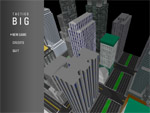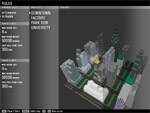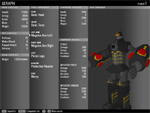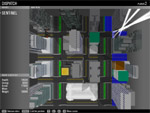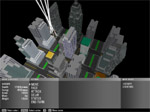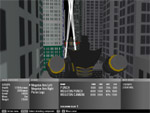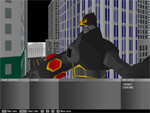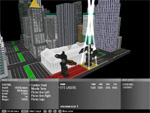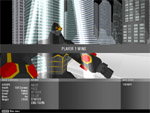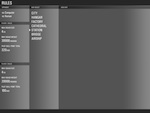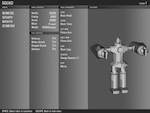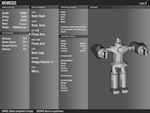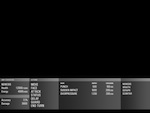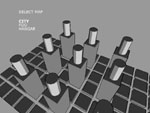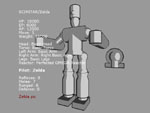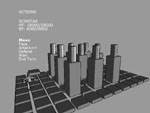Overview
Tactics Big is a turn-based tactical RPG that lets you build and command giant robots in battles that rage through towering cities!
Installation
Download the “TacticsBigInstaller.exe” file to your computer. This is a self-extracting ZIP file.
To install, simply double-click the file to unzip the contents. The contents will be a folder called “Tactics Big”. To play the game, go into this folder and run the “TacticsBig.exe” file.
To uninstall, simply delete the “Tactics Big” folder from your computer.
Keyboard Commands
The status line at the bottom of the screen provides context specific instructions. In general, the following keys are used for the most common actions:
- Arrow keys: Move cursor
- Space: Confirm action
- Escape: Cancel action
The camera can be controlled in most of the game. The camera always looks at a pivot point, which it rotates around. The camera controls use the number keypad:
Numlock Off
- Keypad 7: Zoom in
- Keypad 9: Zoom out
- Keypad 8: Camera up
- Keypad 2: Camera down
- Keypad 4: Camera left
- Keypad 6: Camera right
Numlock On
- Keypad 7: Move pivot up
- Keypad 9: Move pivot down
- Keypad 8: Move pivot forward
- Keypad 2: Move pivot backward
- Keypad 4: Move pivot left
- Keypad 6: Move pivot right
Objective
The object of Tactics Big is to build an army of giant robots and to use them to destroy all of the opponent’s robots.
Robots
The basic unit of Tactics Big is the giant robot, a fearsome machine of destruction. At the beginning of the game, you can construct these robots from a selection of various components. Later, you can command these giant robots to move and attack during the combat phase of Tactics Big.
Robots have several different statistics that define how well they can perform in battle. There are five basic statistics: hit points (HP), energy points (EP), armor points (AP), movement range and weight.
Hit points measure how much damage a robot can take before it is destroyed. When a robot’s hit points reach zero, it’s considered destroyed. It’s clear that you want to have as much HP as possible.
Energy points measure how many actions a robot can take during its turn. Every action costs a certain number of energy points, usually proportionate to its power. The more energy points a robot has, the more it can do each turn.
Armor points measure how well a robot can avoid damage. The higher a robot’s armor points, the less likely it is to be hit by attacks; even if it is hit, a robot with lots of AP won't take as much damage as a robot with less AP.
The movement range measures how many squares a robot can move during its turn.
The weight of a robot has no direct effect in combat, but the cumulative weight of all the robots on your team is limited. The weight limit is imposed to prevent players from making an infinite number of robots.
Components
Each robot is composed of several components, which you assign to your robots early in the game. There are six categories: heads, torsos, arms, legs, reactors and pilots. Each specific component contributes various statistics and attributes to the entire robot. When building your robots, choose wisely! Each component has advantages and disadvantages.
All components, except pilots, contribute the five basic robot attributes (HP, EP, AP, move range and weight) and may contribute attacks. If a component with an attack is equipped, that robot may use that attack in combat. Pilots do not contribute the five basic attributes, instead contributing four pilot-specific statistics: reflexes, melee attack ability, ranged attack ability and defense ability.
Reflexes affect when a robot can act in the turn order. Robots that have pilots with high reflexes (10 is highest, 1 lowest) move before robots that have low reflex pilots.
Melee and ranged attack abilities affect the power of a robot’s attacks. Pilots with better attack ability scores can do more damage and have a better chance to hit their enemies.
Defense ability affects the chance that the robot will be hit by enemy attacks. Defense ability provides a bonus or penalty to the robot’s intrinsic AP score.
Attacks
Attacks are the actions that let you destroy your enemy’s robots. Many components are capable of performing attacks. The choice of component is often really the choice of available attacks. Attacks have four statistics: damage, accuracy, energy cost and cooldown.
Damage is straightfoward, measuring how many hit points of the target robot are removed during a successful hit. The net damage is affected by the attacking pilot’s attack skill score and the target robot’s AP and defense score.
Accuracy measures the chance that the attack will successfully damage the target robot. The net accuracy of an attack is affected by the attacking pilot’s attack skill score and the target robot’s AP and defense score.
Energy cost measures how many energy points are needed to use the attack. If a robot’s current EP is too low, then the attack cannot be used.
Cooldown measures how much energy must be used by other actions before the attack can be used again. That is, most attacks cannot be used immediately in succession. Cooldown is associated with the component that performed the attack.
Attacks also have range and area of effect considerations. Most attacks have limited range; that is, the target robot must be close enough before the attack can be used. If the range is limited to the adjacent squares, then that is a melee attack; all other attacks are ranged attacks. Many attacks also can damage more than one target, which is determined by the area of effect.
Rule Selection
Rule selection is the first stage of the game, where you and your opponent can choose the rules for combat. There are three main rule categories: opponent type, team limits and the map.
The first rule category is opponent type. You can select whether you want to play against the computer or against another person in hotseat multiplayer. Hotseat multiplayer means that both players sit at the same computer and take turns.
The second rule category is team limits. There are three type of limits that can be varied to handicap the game so that a unskilled player may be on an even playing field with a skilled opponent. The three limits are maximum number of robots on each side, maximum total weight per side and total pilot skill points.
The maximum number of robots per side determines how many robots are allowed per side. You do not need to build that many robots, but it is allowed. Weaker players should be allowed to have a larger maximum.
The maximum weight per side constrains the type and number of components allowed for each side. Since more powerful components tend to be heavier, the weight can be a major factor during the build phase. Weaker players should be allowed to have a larger weight maximum.
The total pilot skill points determines how skilled the pilots on each side are. Each side has 10 pilots whose skill points are distributed randomly at the beginning of the game. A larger skill point total results in better pilots which results in more effective attacks. Weaker players should be allowed to have more pilot skill points.
The third major rule category is the map. Here you decide where the battle will take place.
Building Robots
The second stage of the game is the construction of the robots used in combat. Your squad of potential robots is displayed in a list. When you select a robot, you can then equip it with components: head, torso, left arm, right arm, legs, reactor and pilot. For a robot to be usable in combat, it must have all components equipped. Combat-ready robots are marked with a green check mark in the squad list.
Dispatching Robots
After you have built your robots, the third stage of the game is dispatching them on the map. A list of combat ready robots is presented. When you select a robot, it will appear on the map. You may assign them to the blue highlighted squares. After their position is determined, you choose their starting facing, whether they should face north, south, east or west. Repeat this process until all desired robots are on the field.
Combat
Combat is the main event of Tactics Big. In combat, each robot is given its turn to act. The move order is determined only by the reflex ability score of the pilot in each robot; those with higher reflexes move earlier. Robots from either side may be interleaved in the turn order.
During a robot’s turn, it may perform several actions: move, face, attack, delay, status and end turn.
The move action allows the robot to move across the map. The robot may only move in the direction that it is facing. In one turn, a robot may only move as many squares as is indicated by its move range statistic. Each square of movement costs 500 energy points. Legal movement squares are highlighted in blue on the map.
The face action allows the robot to change its direction. A robot may face one of four directions: north, south, east or west. The face action costs 100 energy points.
The attack action has three subactions. First, you select the component that you wish to attack with. Then, a list of attacks associated with that component are listed. After you select an attack, you select the target for that attack. The legal range of the attack is shown on the map as red highlighted squares. The area of effect is shown as yellow highlighted squares.
The delay action allows the robot to use energy to do nothing. This may be useful in order to wait out the cooldown period of an attack. You can select the number of energy points you want to use in increments of 50.
The status action allows you to see all the information about a robot, similar to the build mode. No changes can be made to the robot with the status action, however.
The end turn action signals that the robot is done with its turn and gives the action to the next robot in the move order.
Combat ends when all robots on one side have been destroyed.
Download player’s manual as PDF.

